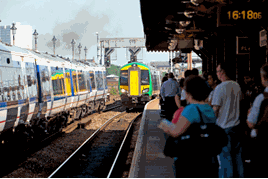But with local control comes local responsibility. While the 14 West Midlands Rail councils will not take any revenue risk (at least for some years), there will be reputational risk that will justify political caution. On the other hand, even though they are very pro-rail, individually the Shire and Unitary authorities have very little clout when it comes to determining rail services. By joining this ‘club of 14’, their voice and influence becomes considerably stronger.
In parallel with these largely political developments, West Midlands Rail has been discussing with the Department for Transport both the London Midland Direct Award franchise (due to run for 18 months from April 2016) and the next LM franchise (from October 2017).
There are ‘soft’ issues to address, such as WiFi on trains and at stations, as well as the challenge of providing sufficient train capacity to allow all those who wish to commute to find space on the trains, and the even bigger challenge of funding capital expenditure on the infrastructure projects that are so desperately needed to optimise rail use.
“The DfT’s High Level Output Specification report in July 2012 said an additional 3,900 seats would be required into Birmingham in the morning peak by 2019,” says Rackliff.
“We’re still some way off even seeing a plan for having that extra capacity delivered, while in the intervening years passenger numbers have continued to grow at twice the rate of industry forecasts. The Direct Award contract will hopefully start to address issues like this, and the process will continue with the next franchise. Solutions cannot wait to the artificial franchise start and end dates.”
In the recent past the West Midlands has fared particularly poorly in the allocation of Government money for major schemes. But the proposed formation next year of the West Midlands Combined Authority, and continuing progress of the three associated Local Enterprise Partnerships, should hopefully unlock further funding to address the region’s priority rail infrastructure schemes.
Nevertheless, regional bodies such as Centro and the LEPs have already played a significant role in progressing schemes such as the extension of services from Solihull to Stratford-upon-Avon, the Walsall to Rugeley electrification, the new station at and electrification to Bromsgrove, and the development of the Nuneaton to Leamington Spa route under the NUCKLE project.
One major project that has long been a WMITA priority, and which was initially a central Birmingham capacity and local rail connectivity project, is the Camp Hill Chords. This is now also closely tied in with the development of the HS2 station at Curzon Street, and has thus become even more important as HS2 is progressed.
Just as in the major northern cities - Leeds, Manchester, Sheffield and Liverpool - the race is on in the West Midlands to provide the best possible rail connectivity to the proposed HS2 services, as they arrive in Birmingham from London in 2026 and from the North in 2033.
The Camp Hill Chords, also known as the Bordesley Chords (RAIL 698), will provide two particular benefits to the West Midlands. Two chords would be constructed - one leading from the Water Orton direction in the east, the other from the Camp Hill line and King’s Norton into the Snow Hill lines through central Birmingham.
Trains using these chords would run directly into Birmingham Moor Street station - the nearest in the city to HS2’s Curzon Street station, which will be located just across a new public square.
The King’s Norton approach gives the opportunity to serve a currently very poorly connected area of south Birmingham. New stations are planned at King’s Heath, Hazelwell and Moseley, and services southwestwards could improve.
Meanwhile, the Water Orton line offers potential to bring trains from the Derby/Tamworth and Nuneaton/Leicester directions into Moor Street - for that vital HS2 connectivity - a move that would also help facilitate new WMR local services on these corridors. This might not be possible if New Street were to be the destination, and where the constraint lies more in the capacity of the approach routes through Proof House Junction than in platform capacity.
There are also aspirations for new local stations to the east - for example at The Fort, Castle Bromwich, Kingsbury and Galley Common (Nuneaton).
To cater for the extra services made possible by the Camp Hill Chords, two bay platforms at Moor Street would be opened.
WMITA is further proposing that Platform 4 at Snow Hill, soon being vacated by the Midland Metro tram, is also brought back into use as a through ‘heavy rail’ platform. This will immediately allow Chiltern Railways to extend the hourly London Marylebone to Moor Street service through to Snow Hill, thus providing a half-hourly London service for the business community, as well as offering potential for improved local services through central Birmingham.
















Login to comment
Comments
No comments have been made yet.